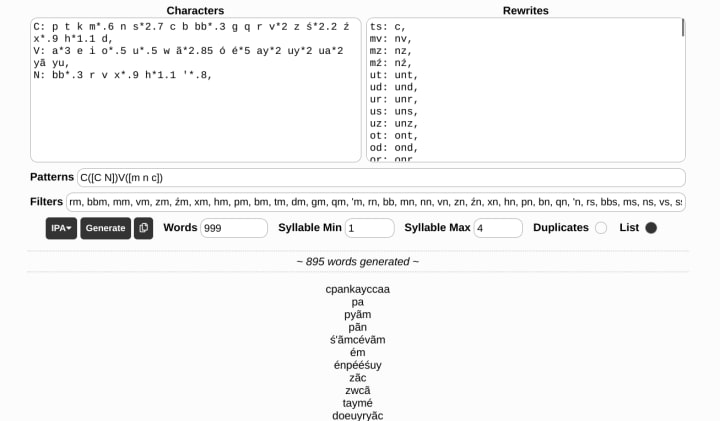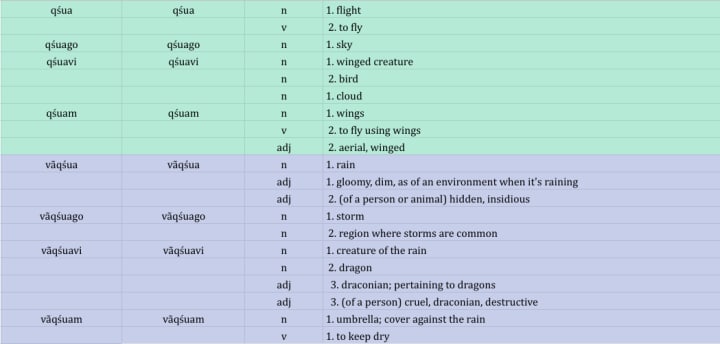Made-Up Words
Creating lexicon that matters

A constructed language, when its foundation is cracked and its structure weak, is like the Las Vegas Eiffel Tower in the face of the Statue of Liberty, or the language the made-up one is based off of, even subconsciously. Not one Eiffel Tower to another, of course, because that would defeat the purpose of it being a conlang, as it were; it's made-up, and despite its clear flaws and inspiration from another monument, it is its own good ol' college try. Which is quite beautiful, at least by intention. In fact, if accidental mimicry in one instantaneous creation of another centuries-long graceful mess is not psychologically required fidelity, I'm not sure what is.
English, for example, is simultaneously one of the most difficult language to learn for non-native speakers, and also likely has one of the largest inventories of words - its lexicon - in the entire world of languages, which is a lot. English has Latin, Germanic, even Japonic and Semitic words within it, such as "major," "flight," "futon," and "alcohol."
One can tell quite a bit about a language based on its lexicon, and for conlangs this is often the case, too. Maybe that's the point; some conlangs are designed to be related to other languages. Some, however, are not, but because there are a finite number of sounds a human can reliably produce, the ways language can be structured is finite, albeit with extreme ranges. Thankfully, those who make conlangs have realized this and have since come up with methods, and indeed programs, to help with creating an inventory of fake words that except for sound and syllable structure, may be nothing close to any existing language.
I myself strive to be different. Or at least have what I decide to come up with sound and look different than most you'll hear or read in the world. But as inexperienced as I admit I am, those aforementioned programs are very useful. Enter: Collin Brennan's GenGo, a generator of words that to me (someone who has never done anything close to actual coding) feels quite like what coding would be. But maybe I'm just extra and unaware of convenience.
The generator works, as explained in this convenient guide, by inputting one's sounds into the big box on the left, filling out the syllable structure in the Patterns box, giving a list of "do this instead" in the big box on the right, and "don't do this at all" in the Filters category. Then, generate with however many you want, and voila:

895 words generated in less than a second in a very helpful list. I suggest you play with it yourself, even you've no clue the rules of language. This generator could be used for something extremely simple, such as just using a couple consonants, a couple vowels, a very simplistic syllable structure and no rules, or the whole mess in the above picture, to create a huge number of stringed-together letters that make a wonderful set of words. For myself, having struggled a long time with no words to test grammar and lack of grammar because of said lexicon drought, I can rest easy and develop language with relative ease: I don't have to think up every single word on my own. I pick two of the options for any random two words, say "flight" and "water", and then develop on my own group of words based off that, like this:

In so little time, 2 groups of words, 8 words total, and 20 different meanings that don't directly correspond to a word and meaning in English. This is done by taking one of the generated words, qśua (pronounced like k-shwah), and adding different affixes based on meaning: qśuago, flight + place = the sky, where flight takes place; qśuavi, flight + animal = a winged creature, a bird, or even just something that moves in the sky, such as a cloud, even if it isn't alive; qśuam, flight + tool = wings, the things that allow birds to fly. And in between each one, there can be derived another meaning - flight is the root, but to fly is the natural verb form of flight, which might be different from qśuam, to fly with wings, since not everything that flies has wings, like clouds. Even then, when another word is added in, like the vã (water) in vãqśua, it becomes flight water, otherwise known as rain. This sparks an entirely new grouping of words, which can have even differing meaning, from the adjective "gloomy" to the verb "keeping dry" to the animal "dragon," which is said to spew fire from above like it was rain.
This process, helped along by the generator, results in a huge plethora of words, and new ones can be created at any time for whatever need; if one were to actually use the language and needed a word, it might be as easy as making one up or deriving one from existing words... and ta-da! Combine these with grammar, syntax, word order, all that linguistic delight, and you have a whole conlang on your hands.
A good conlang works with derivation and harnesses random generation based on predefined rules, and becomes something wholly its own, with influences from whatever the linguist fancies. It is, as a matter of fact, the difference between building the Taj Mahal and the Colossus of Rhodes. Both magnificent, both unique, and both built by such clever humans.
About the Creator
Juniper Washington
I'm a 16-year-old LGBTQ+ creator who writes to express and improve, who reads to learn and accept, and who lives to better the future of myself and anyone I can meet.






Comments
There are no comments for this story
Be the first to respond and start the conversation.